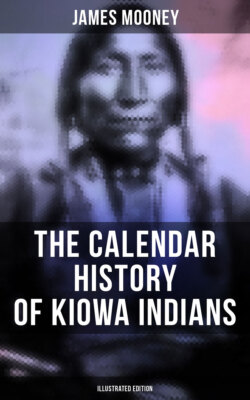Читать книгу The Calendar History of Kiowa Indians (Illustrated Edition) - James Mooney - Страница 22
На сайте Литреса книга снята с продажи.
ОглавлениеThe Historical Period
Table of Contents
Possession of the Black Hills
Table of Contents
We come now to more definite historic ground. Situated east of the Crows, the Kiowa took possession of the Black Hills (Sádalkáñi K`op, "stomach-rind, i. e., 'manifold,' mountains"), and having by this time procured some horses, began to make raids on the Spanish frontiers to the south, while they established a friendly trade and intercourse with the Arikara and Mandan on the Missouri. They are mentioned under the name of Cargua (for Caigua) in a Spanish document of 1732, and again as Caigua in 1735. In 1748 the Spanish historian Villaseñor mentions the "Cayguas," in connection with Comanche, Apache, Navaho, and Ute, as among the hostile tribes of New Mexico (see the synonymy). It will be remembered that the greater portion of what is now Colorado was included with New Mexico under Spanish domination. If, as seems possible, they are identical with the Manrhoat or Manrhout of La Salle, allies of the Gattacka (Kiowa Apache), our knowledge of the tribe would go back to 1682. They continued to occupy the Black Hills until about the close of the last century, when they were driven out by the Dakota advancing from the east, and by the Cheyenne who crossed the Missouri from the northeast. The same pressure drove their old allies, the Crows, farther westward.
The northern Cheyenne informed Grinnell that on first coming into their present country they had found the region between the Yellowstone and Cheyenne rivers, including the Black Hills, in possession of the Kiowa and Comanche (?), whom they drove out and forced to the south. When the author was among the Dakota some years ago, they informed him that they had first known the Kiowa in the Black Hills, and had driven them out from that region. This is admitted by the Kiowa, who continued at war with the Dakota and Cheyenne until about 1840, when a permanent peace was made. It does not appear that the Arapaho had anything to do with this expulsion of the Kiowa, with whom they seem generally to have been on friendly terms, although at a later period we find them at war with the Kiowa, being probably drawn into hostilities through their connection with the Cheyenne. As is well known to ethnologists, the Dakota are comparatively recent immigrants from east of the Missouri. They first reached the Black Hills in 1775, as already stated, so that the final expulsion of the Kiowa must have occurred between that date and 1805, when Lewis and Clark found the Cheyenne in possession of the same region, the Cheyenne being then at war with the Dakota. Curiously enough, there is no note of this war on any of the several Dakota calendars covering this period, described and illustrated by Mallery, although we find a reference to the killing of a Kiowa in the winter of 1814—15.
